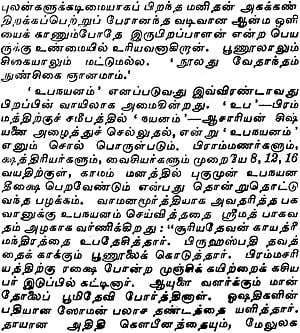

In letter counting, the word vareṇyam (वरेण्यं) is considered vareṇiyam (वरेणिं). These five heads represent the 5 among Vedangas, namely vyākaraṇa, śikṣā, kalpa, nirukta and jyotiṣa. The six bellies are said to represent the 4 cardinal directions, along with the other two directions, Ūrdhva (Zenith) and Adhara (Nadir). The Taittirīya Sandhya Bhāṣyam of Sri Krishna Pandita states that the three legs of the Gayatri are supposed to represent the first 3 Vedas (Ṛk, Yajus, Sāma). In Mahanarayana Upanishad of Krishna Yajurveda, Gayatri is described as white-colored (Sanskrit: श्वेतवर्णा, śvetavarṇā), having the gotra of sage viswamitra (Sanskrit: सान्ख्यायनस गोत्रा, sānkhyāyanasa gotrā), composed of 24 letters (Sanskrit: चतुर्विंशत्यक्षरा, caturviṃśatyakṣarā), three-footed (Sanskrit: त्रिपदा, tripadā), six-bellied (Sanskrit: षट्कुक्षिः, ṣaṭkukṣiḥ), five-headed (Sanskrit: पञ्चशीर्षः, pañcaśīrṣaḥ) and the one used in Upanayana of dvijas (Sanskrit: उपनयने विनियोगः, upanayane viniyogaḥ).

According to Nṛsimha, it is so called because it is complete meditation.According to Mādhava, it is so called because it is performed at the time called Sandhyā (i.e.Morning is called Gāyatrī (which is white in colour), noon is Sāvitrī (which is red), evening is called Sarasvatī (which is black or dark blue). According to Vṛddha Yājñavalkya, Sandhyā is a special devata that governs these parts of the day.

Thus, the word Sandhyā secondarily means all those actions which are to be performed at a given time as a daily practice. The conjunction of day and night-that is, the time when there are neither stars nor sun-twilight is called Sandhyā. In the Udyogaparva (82.21) of the Mahabharata, there is a reference to Krishna performing Sandhya. In the Balakanda (23.2, 23.2) of the Ramayana, Visvamitra wakes Rama and Lakshmana at dawn to worship sandhya. The practice of Sandhya can be observed in Ramayana and Mahabharata by Rama and Krishna. Sandhyopasana is considered the path to attain salvation (moksha). ‘salutation to the communities of (goddess) Sandhyā’ or ‘supposed salutation which is consecrated daily by a religious ‘dvija’) is a traditional custom through a sacred thread ceremony called Upanayanam and instructed to be performed by the Guru, in in this case qualified to teach Vedic ritual. Sandhyavandanam (Sanskrit: संध्यावन्दनम्, sandhyāvandanam, lit.


 0 kommentar(er)
0 kommentar(er)
